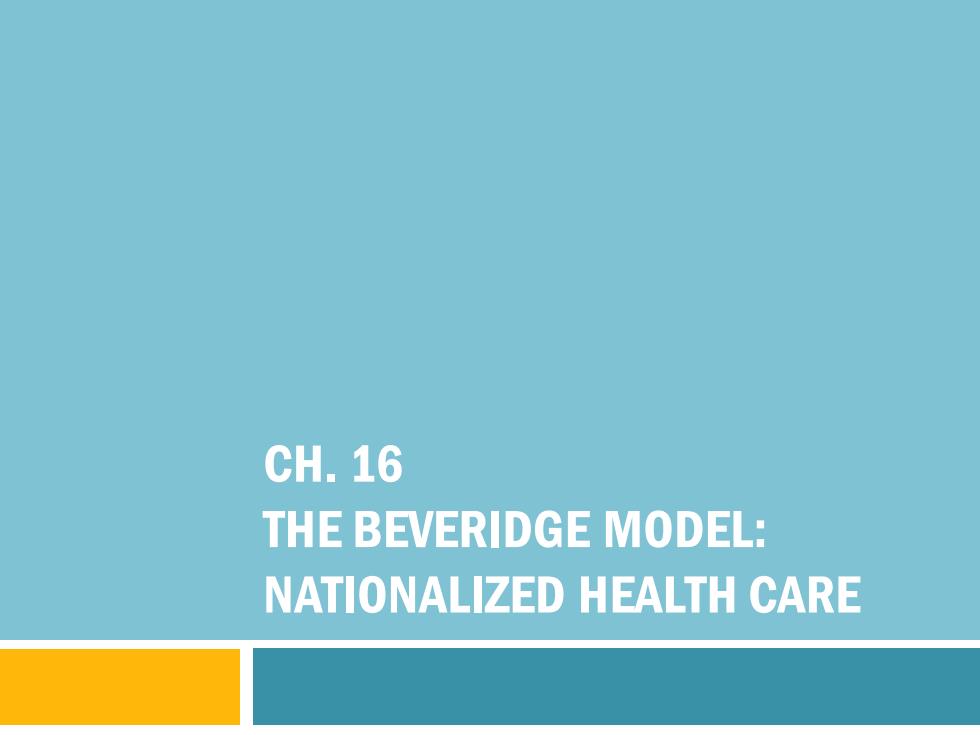
CH.16 THE BEVERIDGE MODEL: NATIONALIZED HEALTH CARE
CH. 16 THE BEVERIDGE MODEL: NATIONALIZED HEALTH CARE
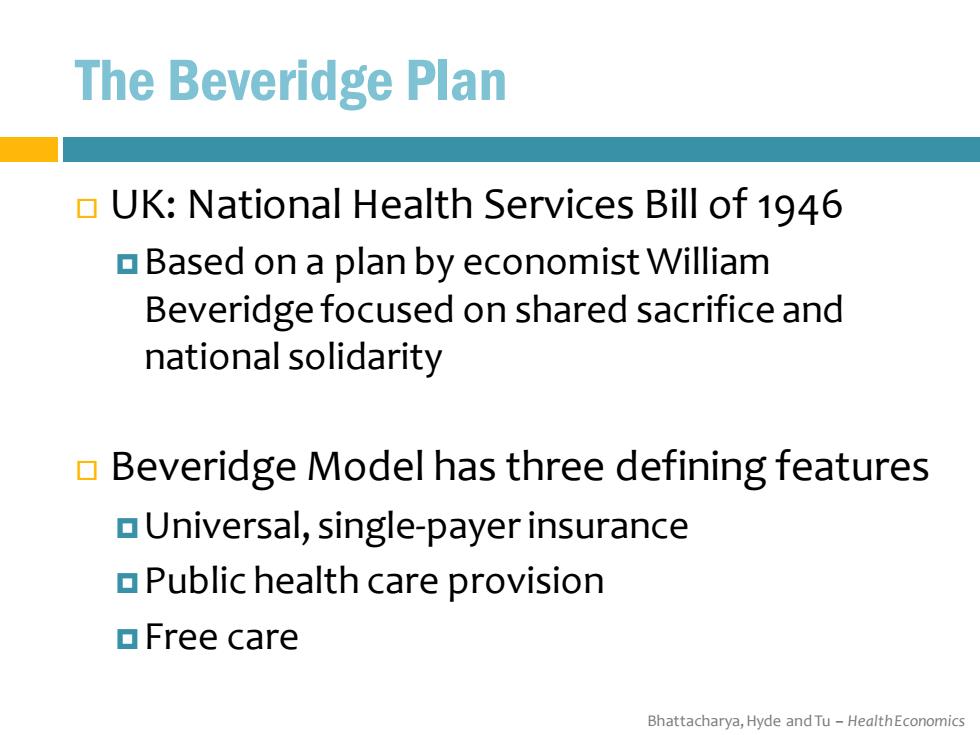
The Beveridge Plan UK:National Health Services Bill of 1946 Based on a plan by economist William Beveridge focused on shared sacrifice and national solidarity Beveridge Model has three defining features Universal,single-payer insurance Public health care provision ▣Free care Bhattacharya,Hyde and Tu-HealthEconomics
Bhattacharya, Hyde and Tu – Health Economics The Beveridge Plan UK: National Health Services Bill of 1946 Based on a plan by economist William Beveridge focused on shared sacrifice and national solidarity Beveridge Model has three defining features Universal, single-payer insurance Public health care provision Free care
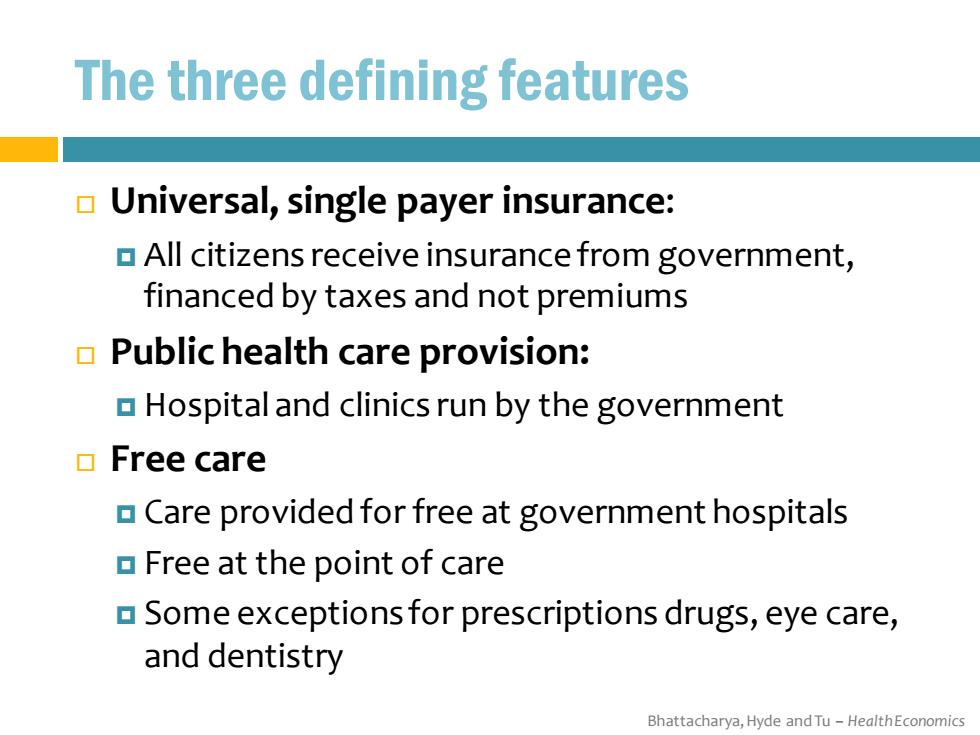
The three defining features Universal,single payer insurance: All citizens receive insurance from government, financed by taxes and not premiums Public health care provision: Hospital and clinics run by the government Free care Care provided for free at government hospitals Free at the point of care Some exceptions for prescriptions drugs,eye care, and dentistry Bhattacharya,Hyde and Tu-HealthEconomics
Bhattacharya, Hyde and Tu – Health Economics The three defining features Universal, single payer insurance: All citizens receive insurance from government, financed by taxes and not premiums Public health care provision: Hospital and clinics run by the government Free care Care provided for free at government hospitals Free at the point of care Some exceptions for prescriptions drugs, eye care, and dentistry

Aim of the Beveridge model Health care is a good provided by the government and paid for with tax revenue Like public schools,libraries,and parks Allocation of health care based on need and not ability to pay Eliminates price rationing Promotes equity Bhattacharya,Hyde and Tu-HealthEconomics
Bhattacharya, Hyde and Tu – Health Economics Aim of the Beveridge model Health care is a good provided by the government and paid for with tax revenue Like public schools, libraries, and parks Allocation of health care based on need and not ability to pay Eliminates price rationing Promotes equity
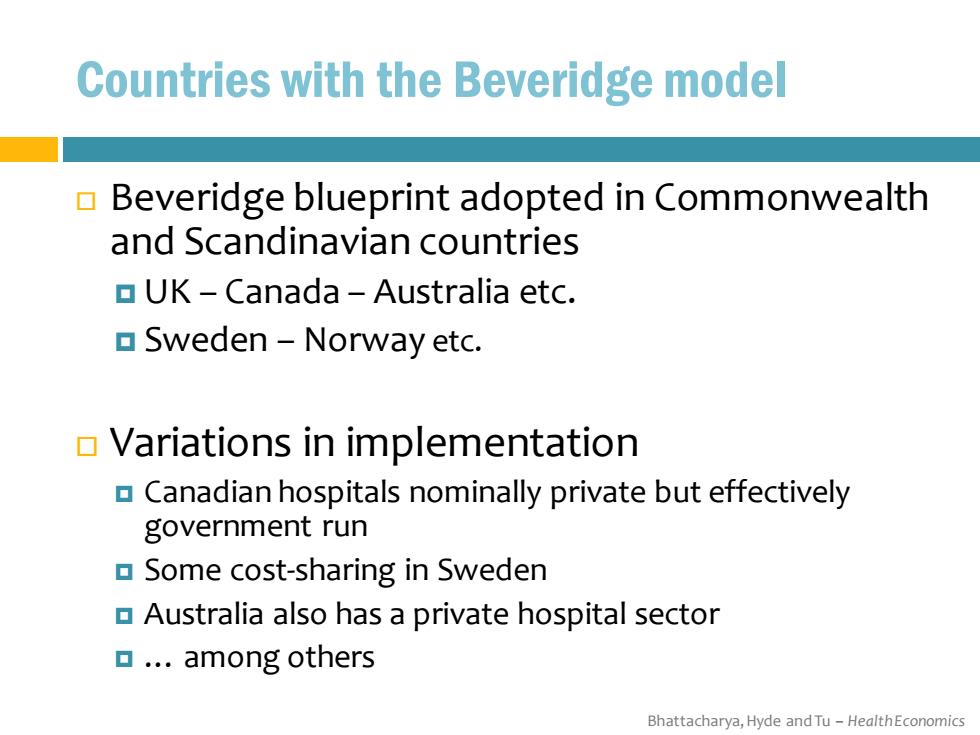
Countries with the Beveridge model Beveridge blueprint adopted in Commonwealth and Scandinavian countries UK-Canada-Australia etc. Sweden-Norway etc. Variations in implementation Canadian hospitals nominally private but effectively government run Some cost-sharing in Sweden Australia also has a private hospital sector ▣..among others Bhattacharya,Hyde and Tu-HealthEconomics
Bhattacharya, Hyde and Tu – Health Economics Countries with the Beveridge model Beveridge blueprint adopted in Commonwealth and Scandinavian countries UK – Canada – Australia etc. Sweden – Norway etc. Variations in implementation Canadian hospitals nominally private but effectively government run Some cost-sharing in Sweden Australia also has a private hospital sector … among others

Rationing health care without prices Every health care system faces two fundamental questions: how much health care should be produced? ▣who should get it? Private markets use prices to answer these questions Scarce resources go to those willing and able to pay the most for them (price rationing) With price rationing,poor are disadvantaged Bhattacharya,Hyde and Tu-HealthEconomics
Bhattacharya, Hyde and Tu – Health Economics Rationing health care without prices Every health care system faces two fundamental questions: how much health care should be produced? who should get it? Private markets use prices to answer these questions Scarce resources go to those willing and able to pay the most for them (price rationing) With price rationing, poor are disadvantaged
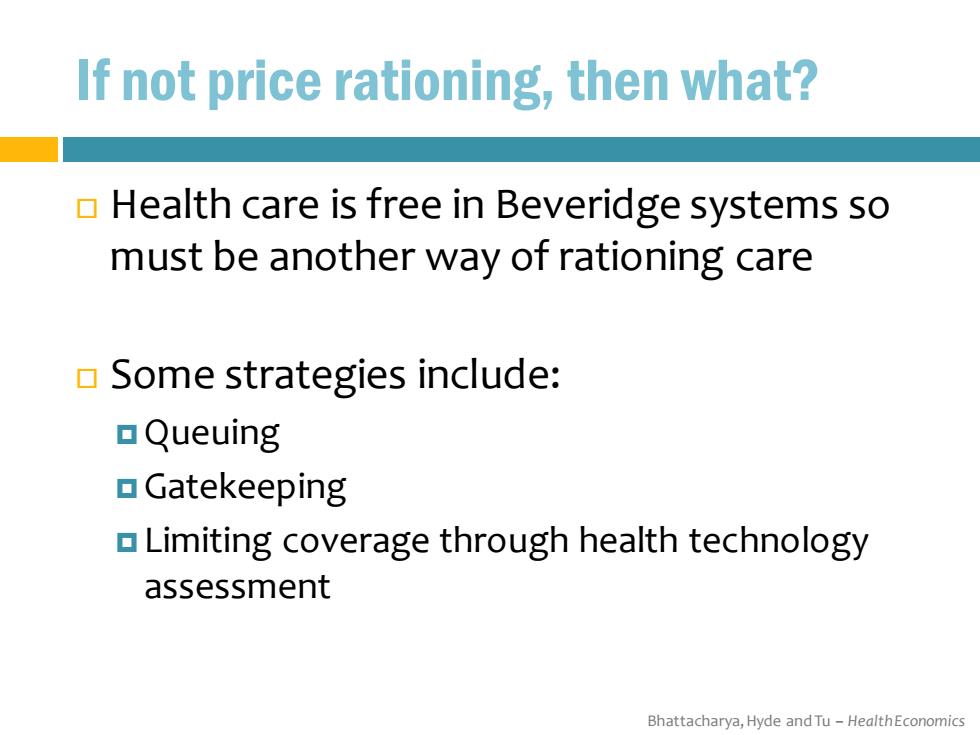
If not price rationing,then what? Health care is free in Beveridge systems so must be another way of rationing care Some strategies include: Queuing Gatekeeping Limiting coverage through health technology assessment Bhattacharya,Hyde and Tu-HealthEconomics
Bhattacharya, Hyde and Tu – Health Economics If not price rationing, then what? Health care is free in Beveridge systems so must be another way of rationing care Some strategies include: Queuing Gatekeeping Limiting coverage through health technology assessment
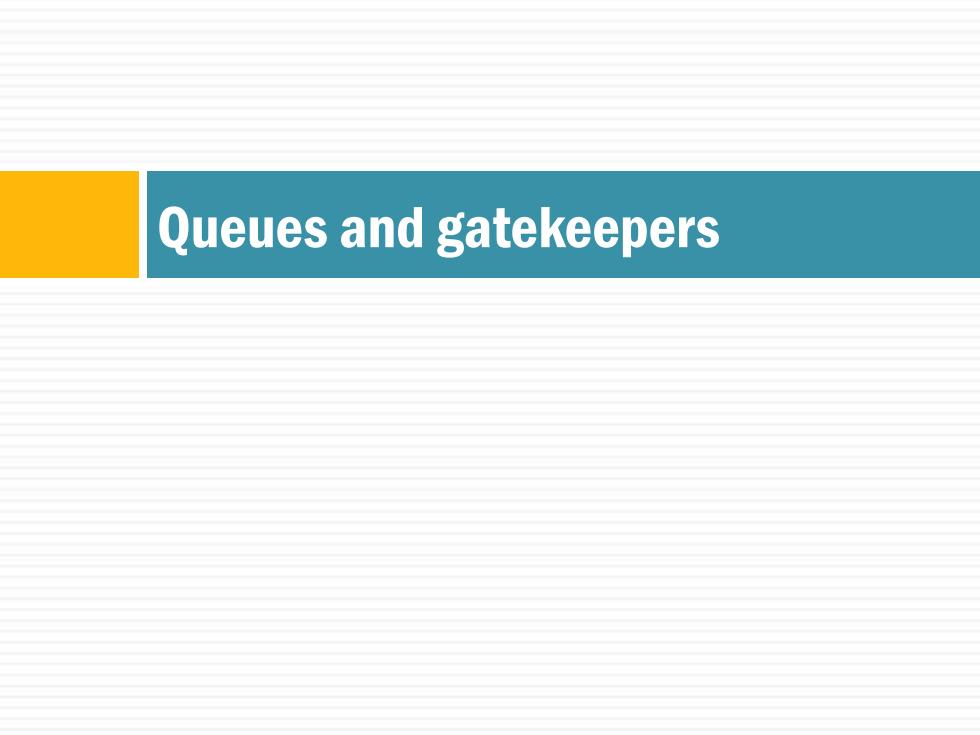
Queues and gatekeepers
Queues and gatekeepers
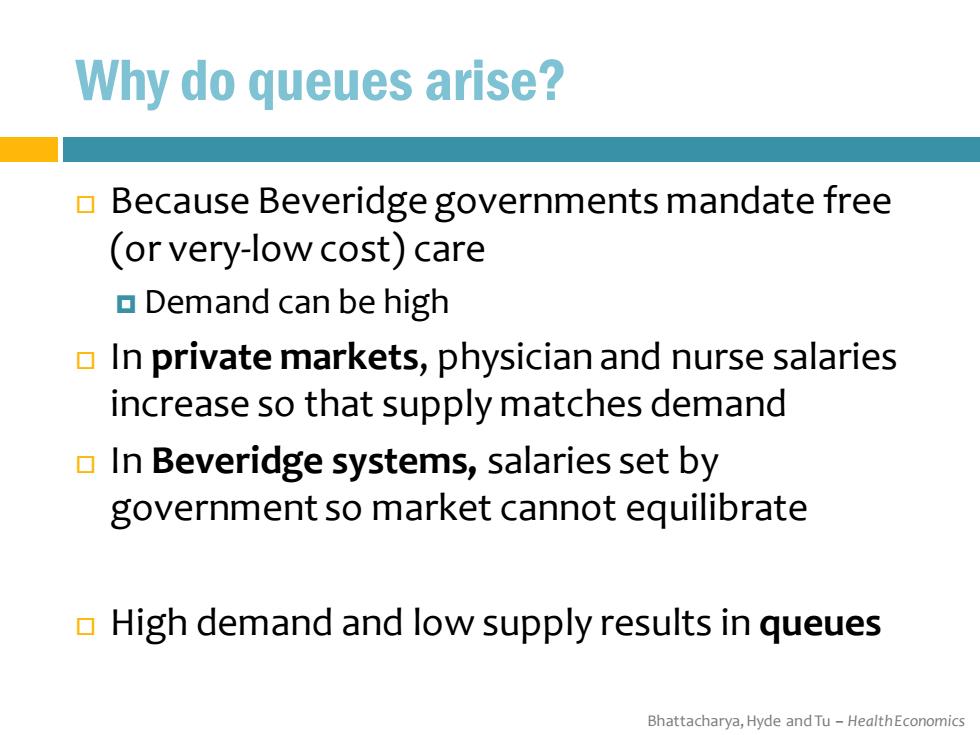
Why do queues arise? Because Beveridge governments mandate free (or very-low cost)care Demand can be high In private markets,physician and nurse salaries increase so that supply matches demand In Beveridge systems,salaries set by government so market cannot equilibrate High demand and low supply results in queues Bhattacharya,Hyde and Tu-HealthEconomics
Bhattacharya, Hyde and Tu – Health Economics Why do queues arise? Because Beveridge governments mandate free (or very-low cost) care Demand can be high In private markets, physician and nurse salaries increase so that supply matches demand In Beveridge systems, salaries set by government so market cannot equilibrate High demand and low supply results in queues
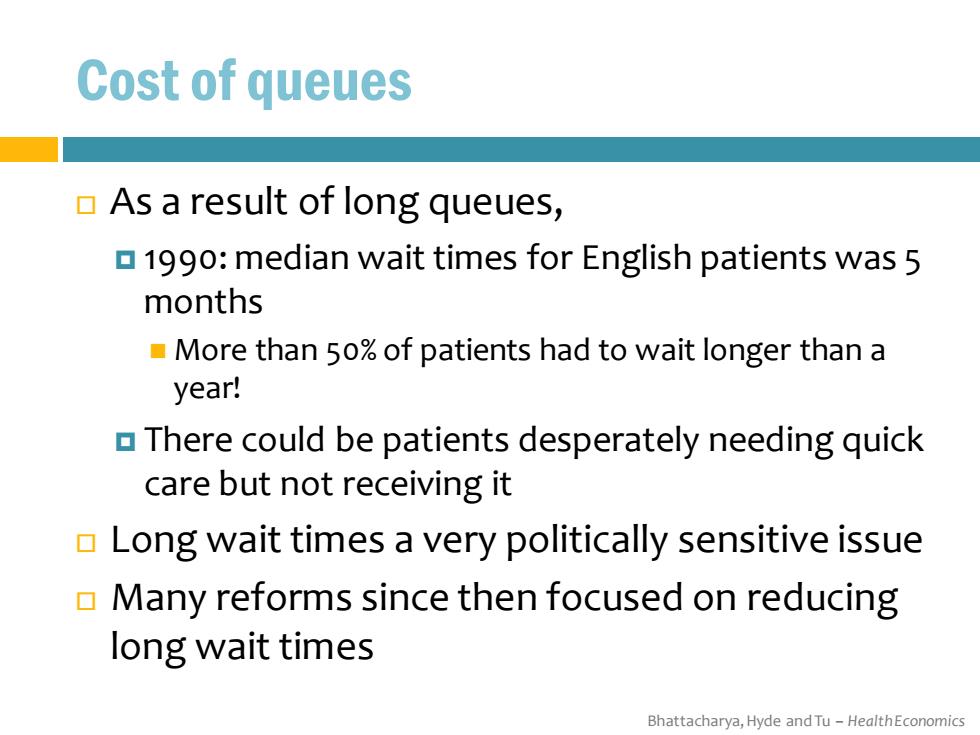
Cost of queues As a result of long queues, 1990:median wait times for English patients was 5 months More than 50%of patients had to wait longer than a year! There could be patients desperately needing quick care but not receiving it Long wait times a very politically sensitive issue Many reforms since then focused on reducing long wait times Bhattacharya,Hyde and Tu-HealthEconomics
Bhattacharya, Hyde and Tu – Health Economics Cost of queues As a result of long queues, 1990: median wait times for English patients was 5 months ◼ More than 50% of patients had to wait longer than a year! There could be patients desperately needing quick care but not receiving it Long wait times a very politically sensitive issue Many reforms since then focused on reducing long wait times